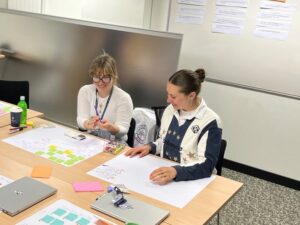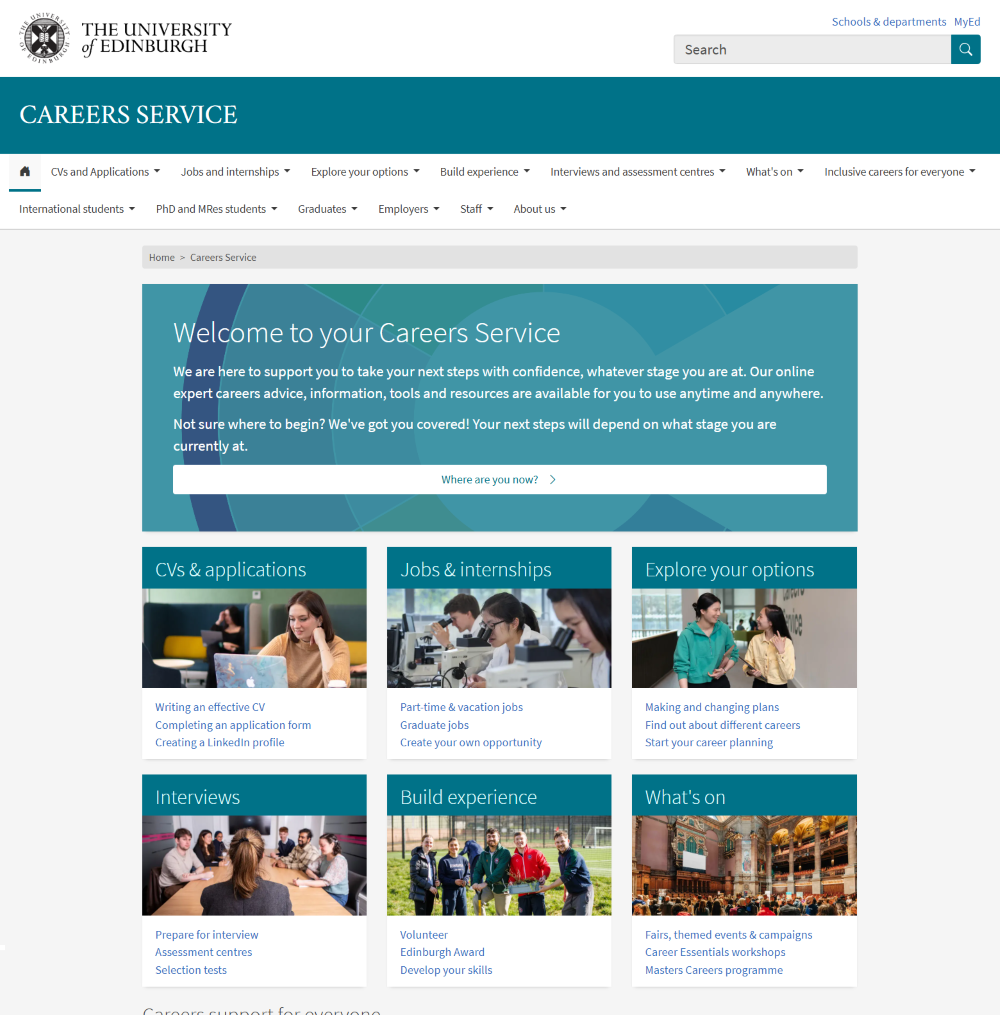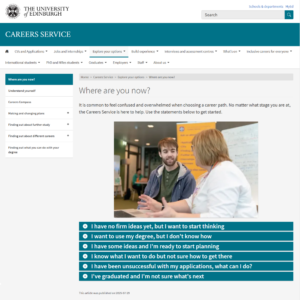How we used a sketching workshop to support the Careers Service with their website redesign
This year, the UX Service have been working with the Careers Service as they review and restructure their web content. In June, we worked with Careers Service staff to run a sketching workshop that would help us to understand the expectations that students bring with them when they use the Careers Service website.
This workshop was part of a wider series of activities that we’ve run with the Careers Service to engage colleagues and service users with their content development work.
These sessions have included:
- a content strategy workshop where we helped the Careers Service staff to outline what they need their website to do, and what they know about user needs of their service
- a user flow mapping session with Careers Service staff who have expertise in the PhD student audience.
Read about these sessions here:
Working with the Careers Service on their content strategy (Nick Daniels)
Alongside this, the Career Service have independently run their own user engagement sessions, which has been great to see. In April, they set up a table in the ground floor of the Main Library and asked passing students if they could spare a couple of minutes to talk about their use of the Careers Service website. Students were happy to chat. Careers Service staff presented three mock-ups of potential changes to the homepage, and these worked as effective conversation prompts for students to explain what they need from the website.

The Careers Service used mock ups presented in the Main Library to engage with users and get feedback.
UX practitioners often emphasise the importance of approaching user research as a team sport. When multiple members of a team get direct exposure to user feedback, this adds nuance to the design process and motivates teams to take the findings on board.
Fast path to a great UX – increased exposure hours (Jared Spool)
This was a perfect example of this. And it made a difference: user feedback from these sessions helped the Careers Service make decisions about what to include on their homepage and what wording was going to make sense to their audiences.
Sketching helps you to understand user expectations
With the sketching workshop, we wanted to build on what we’d learned from previous engagement sessions, and learn more about the expectations that students bring to the Careers Service.
These expectations can be about:
- what the service provides
- what various parts of the service are called
- how things will be grouped together on a website.
When we design in line with user expectations, we’re more likely to create predictable interactions and websites that are easy to navigate.
In a sketching workshop, participants draw out an interface and explain the reasons behind what they’ve drawn. By listening to these explanations – and the conversations that happen around them – we can learn more about the expectations that those users have of a service. Sometimes a small comment from a user can provide an insight into what they need from a service and what’s important to them.
How our sketching workshop with the Careers Service worked
For our sketching workshop with the Careers Service, we invited six student interns to join us at an in-person session at the Main Library. After a brief introduction to the session and an outline of what we’d be doing, we passed round the paper and the felt-tips.
The first task was for students to draw out what they would expect to see on a Careers Service website. Some students drew a rough wireframe of a homepage, and others drew a mind map or spider diagram. The format wasn’t important here; we just wanted to get the ideas on paper so that students could talk about what they were expecting to find on the site.
When the drawings were complete, each student described what they’d included and why.
Students then split into two groups and looked at how their initial designs would accommodate different user groups and their common tasks.
These took the form of Careers Readiness Statements. For example:
- I want to spend some time gathering more experience before I make long term plans.
- I am ready to apply for graduate level professional work opportunities.
This helped to integrate the students’ initial designs with our existing understanding of student users of the Careers Service.
Finally, the students came together and discussed how they would change their designs with consideration of these different user groups. This allowed them to consolidate common patterns while taking into account a broader range of user needs.

Student interns helped us by designing pages in a sketching workshop.
What we learned
This workshop was part of a wider series of activities that the Careers Service have run to find out what their users need from them, and the role their website plays in meeting those needs. Some of what we heard in the sketching workshop confirmed what we had learned in previous research.
Top tasks consistently stand out when we ask students what they want from the Careers Service
Students told us they expect the Careers Service website to provide help with top tasks such as:
- get help with a job application (CVs, cover letters and interviews)
- find a job
- find out what I can do with my degree.
The session backed up what we’d learned about these top tasks elsewhere, but it also added some nuance to our understanding of them.
When the new Careers Service website went live last week, it was exciting to see the top tasks prominent and easy to find in the new design.

The new Careers Service homepage, launched in August 2025.
The previous homepage presented audience groups that the website served, with top tasks such as CVs and applications up to four clicks away:

The previous Careers Service homepage.
Student needs change as they progress through their degree
When explaining their designs in the workshop, students described themselves as being at different stages of their degree, and talked about how this influenced what they need from the Careers Service. For instance, in their first year, a career might seem a long way off. First-year students might be interested less in the job market, and more in how joining a student society could help them to gain skills. In second and third year, students might be looking at how to get experience in a particular field. And in fourth year, they might want support in finding professional or academic opportunities that can help them get started in a career that’s of interest to them.
We can view student needs existing on a timeline, and changing as they get closer to graduation and pursuing full-time employment.
This viewpoint, together with the Careers Readiness Statements described above, helped to inform the design of this page:
Where are you now? | Careers Service

The “Where are you now?” page on the new Careers Service website caters for the varying needs of their student audience.
Students suggested a calendar to stay up to date with upcoming application windows
There were some concrete suggestions for content that students said they would find useful. For example, some students described their need for a calendar highlighting when annual opportunities become available. For instance, some companies open up applications for summer internships at the same time every year; students in the session said it would be useful to know when these application windows are coming up.
Sketching helped to inform language choices
In the sketched examples, we saw the language students used for certain sections of the site, and where this matched up with (or differed from) the way we talk about those things internally. This helped the Careers Service to make decisions about how to link to and label areas of their site.
Emotional user needs matter too
When we started this collaboration with the Careers Service, our focus was on the tasks that their users were looking to complete. As the project has progressed, we’ve come to appreciate that as well as tasks, students also come to the Careers Service with a range of emotional needs. These can include the feelings of anxiety and overwhelm that can sometimes accompany the process of seeking out opportunities and knowing which careers will be a good fit for you.
While it’s important to design a website that serves your users’ top tasks, it’s also useful to incorporate an awareness of the emotional needs that users come with. This can help to inform how you write a piece of content and the tone of voice you adopt.
Seeing user-centred design in action
This has been an inspiring project to work on, and it’s been fun to see a range of user-centred approaches come together and see how they feed into a design process. There’s been a massive effort from the Careers Service to get to this point, and it’s great to see the website go live.

